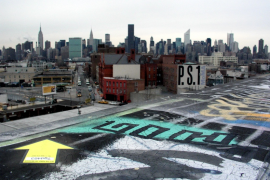This British Airways ad campaign from a few years ago presented digital images of children that were designed so that it appeared that they were noticing and pointing to real life airplanes as they passed over the billboard. Viewed from the right angle, the custom “surveillance technology” (probably relying in part on ordinary flight schedule data) that BA’s advertising company employed was able to mimic a child delight at something passing in the sky overhead.
While they’re not “literature” (at least by most definitions, though maybe Lew Welch would disagree), these ads nevertheless showcase the kinds of evocative possibilities that are enabled by using data flows and sensor networks. Of course, what remains central to these, no matter the technologies involved, is the way in which they tap into existing cultural forms and practices (billboards, the image of childhood delight, the way that planes fly overhead) in order to create their effect. The technologies merely ride atop networks of human activity that would otherwise remain invisible.
A very different example of how these kinds of invisible entangled networks that can be leveraged is Trespass, an iOS app designed by the artist Layla Curtis and programmed by Ron Herrema (himself an artist and composer). The app is focused on a piece of land called Freeman’s Wood that had been for years used by residents of Lancaster for hiking, dog walking, bird watching and the like, only to one day be fenced off and posted with “No Trespassing” signs. The former site of a linoleum factory, after remaining derelict and unused apart from local residents for whom the land functioned as a common village green, the land was reclaimed by its owners (under the auspices of a company registered in Bermuda) to be re-zoned under a proposal to turn it into a housing development. With the land’s owners supposedly based out of Hong Kong and the transaction being managed by an intimate of the Royal Family, as one local organizer put it, “this scrubby patch of land has direct links to global economic, political and social networks.”
The app is interesting in that in order to access the content of the application — voices from local residents describing their relation with the disputed plot of land — you need to be physically present within the boundaries of the now fenced-in and posted area. By utilizing the GPS location of the users, the app makes it necessary to trespass on the land in order for the app to function (a few of the audio tracks that are set outside of the disputed area are, thankfully, available to anyone, anywhere). Of course, any claim of right over the land by the local residents is predicated on the fact of their continued and unimpeded use of the land for so long, with Trespass encouraging the continuation of this use of the land as public.
At its root, Trespass encourages a reflection on the various (and sometimes contradictory) networks of rights and claims that come to entangle a piece of land, with that land coming to hold different meanings depending on the context of your perspective. By linking the function of the app to the specific geofenced area of Freeman’s Wood, and having users traverse the spaces within the wood, the app directly engages the political and cultural contexts that influence our thinking about land ownership, rights, and law. In a unique way, the app places users into the invisible and yet enormously important context of contemporary questions of property and how global financial systems can impact something as simple as taking a walk in the woods.
In distinctly different ways and with distinctly different intents, these two examples illustrate how it is possible to harness global networks — not only of communication but of culture as well — toward the creation of evocative works. This funneling together of these different kinds of materials (technological and cultural) into a coherent aesthetic experience exemplifies the foundation of ambient literature thinking. What is shared between these experiences is the common locus of the participant (either the passerby viewing the billboard from just the right angle or the person trespassing in Freeman’s Wood) which serves to anchor these experiences in an intelligible and common world. Such works do not represent an inward consideration of self-consideration, but each offers the chance for a deeper engagement with a world and ideas that are as much present as not.









2 Comments
The 9 Things Your Parents Taught You About Top British
Pornstars top british Pornstars
An Easy-To-Follow Guide To Jackpot Slots random jackpot slots